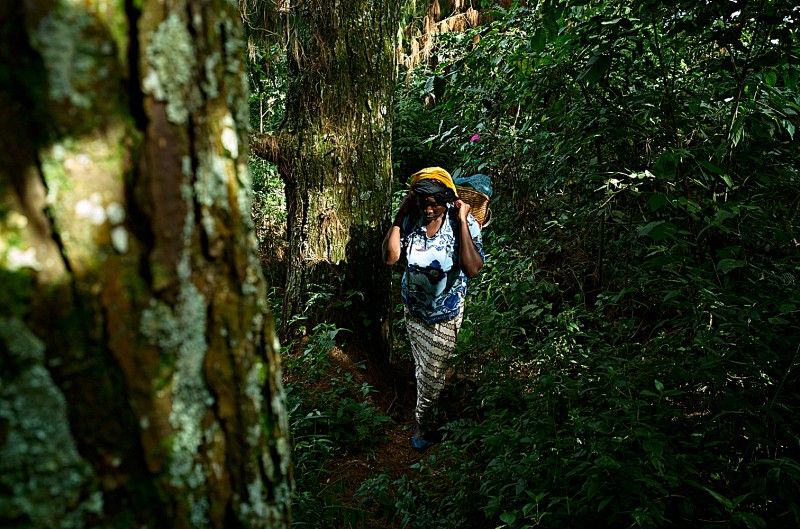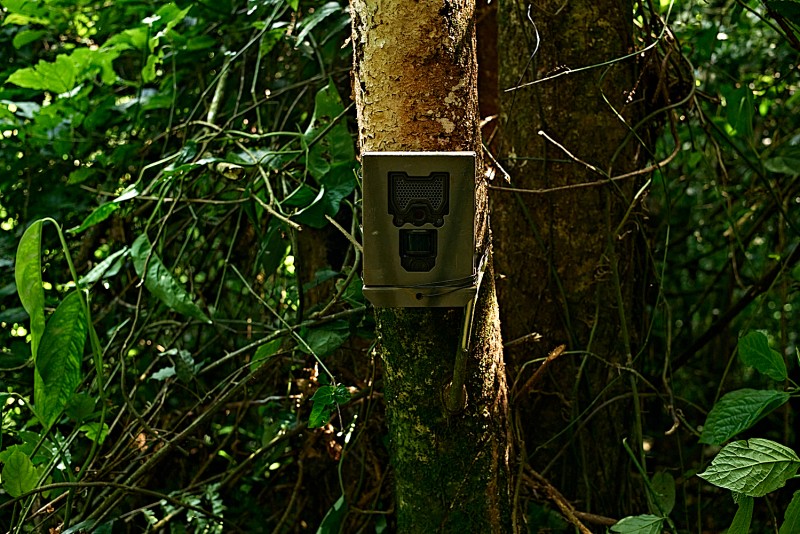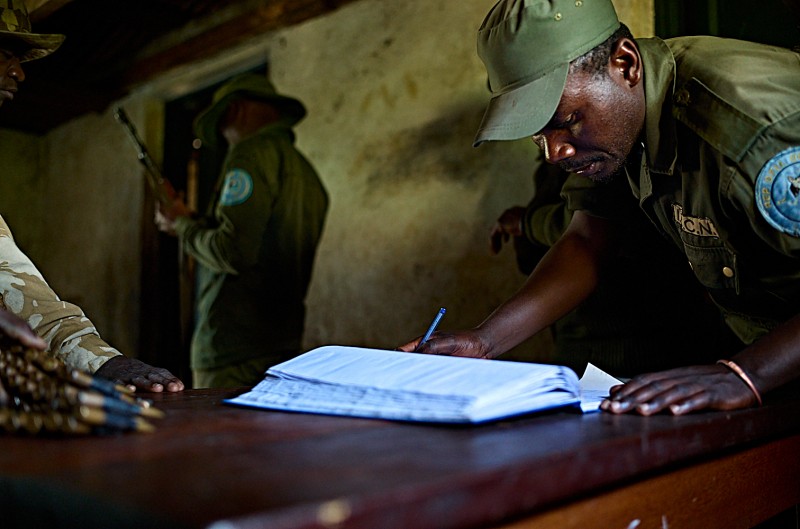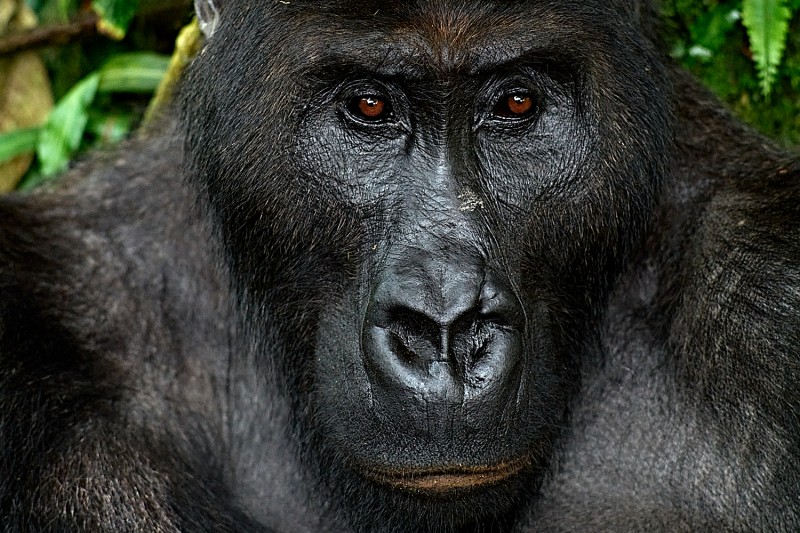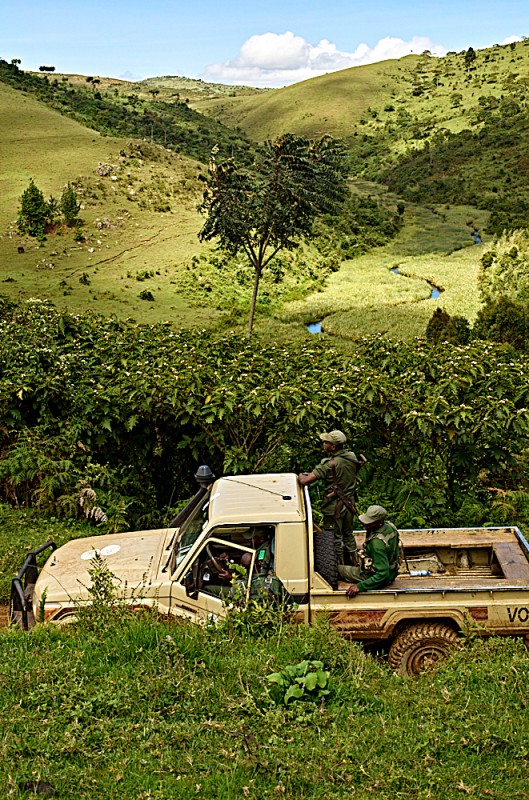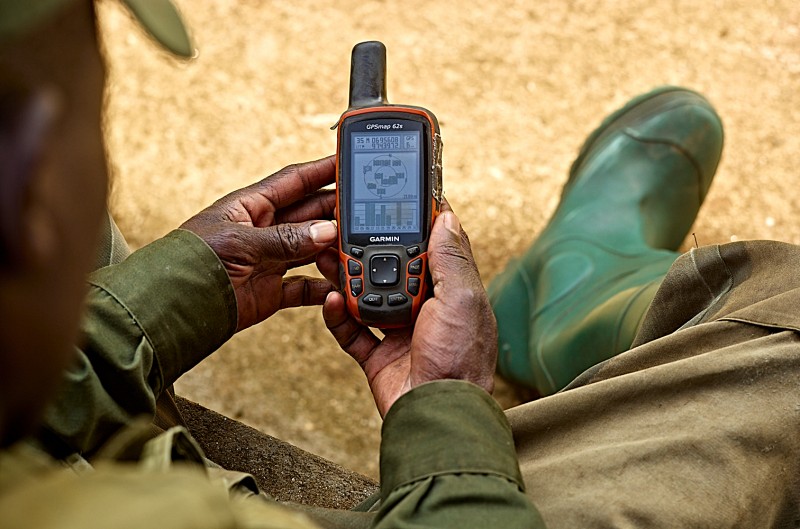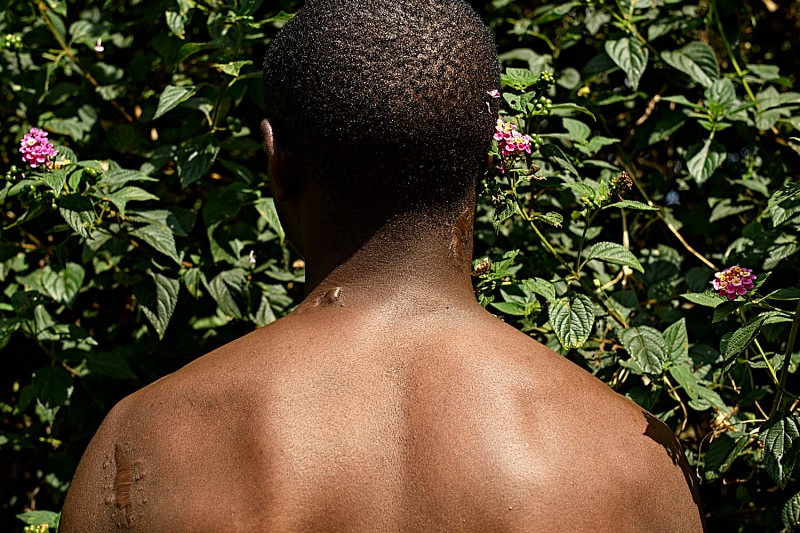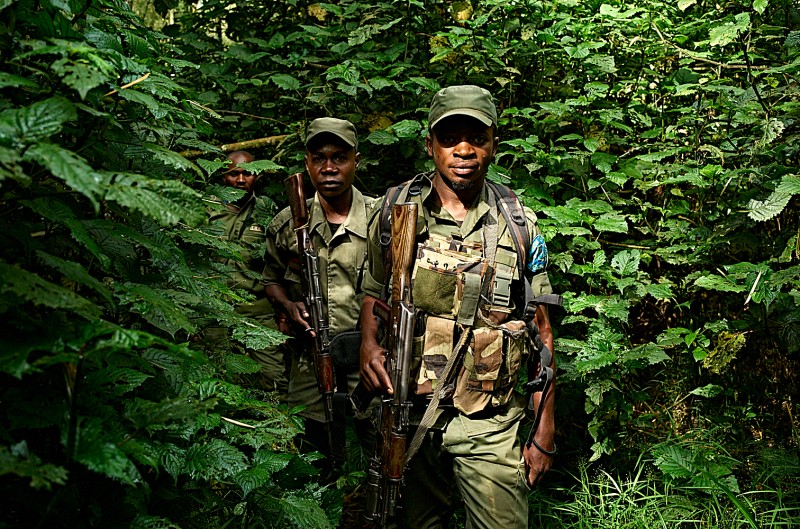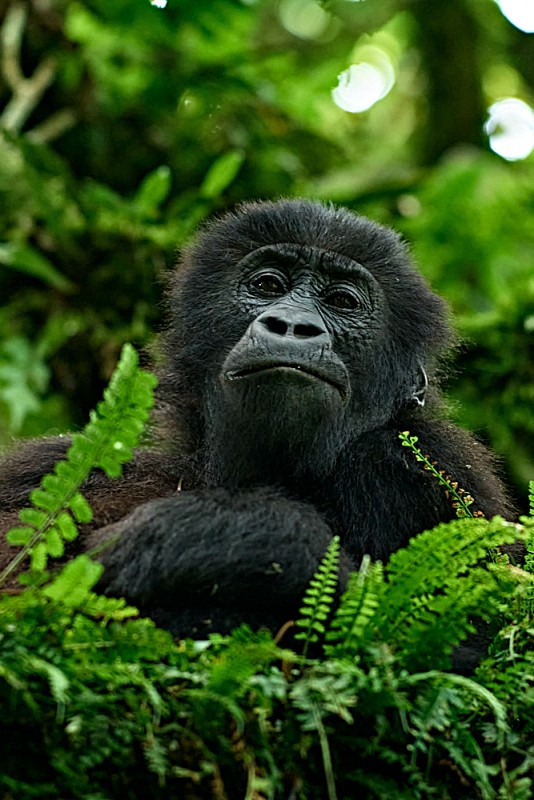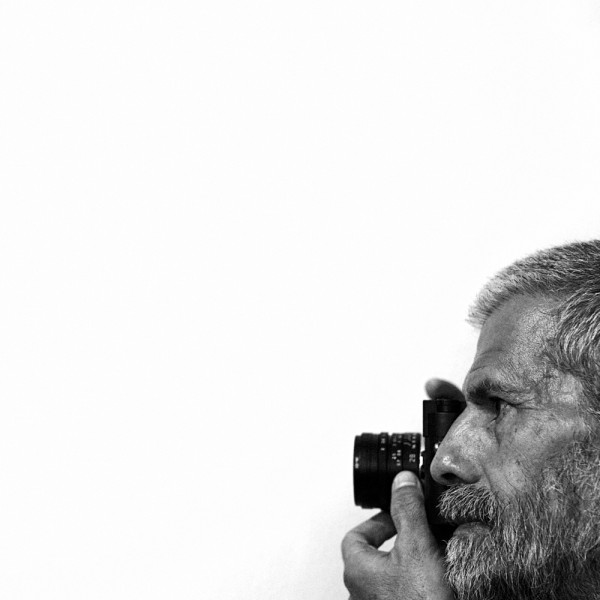Ecoguardians of the Kahuzi-Biega National Park
Ecoguardians of the Kahuzi-Biega National Park
Robert Carrubba
February 10, 2022
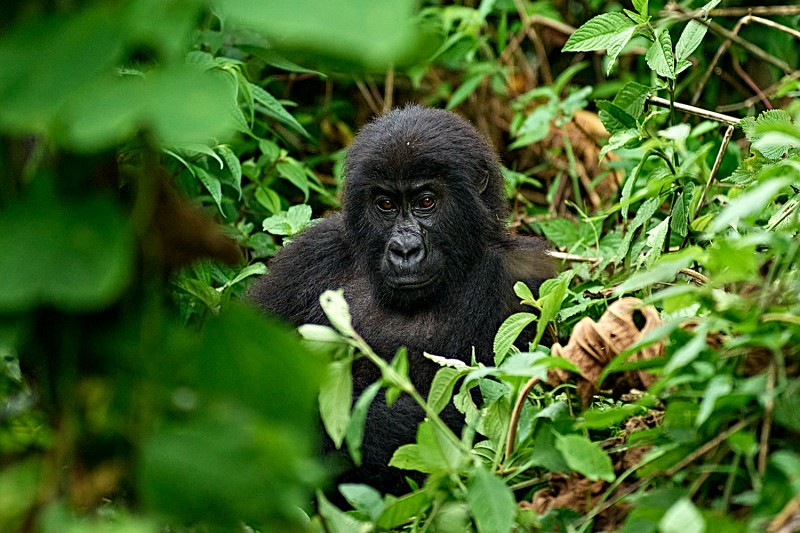
LFI: What brought you to Congo? What was the impetus for your project?
Robert Carrubba: In the Democratic Republic of the Congo, I made photographs of the most recent electoral period from 2016-18, as well as for collaborative in-depth projects that involve subject-matter experts, and engage directly with people who tell their own stories in detail, such as WEWA!, on urban moto-taxi drivers in Kinshasa; From Extraction to Final Product, about the processes of artisanal gold mining in the East; and Gestures – Tools – Engines – Soils, about the use of Congolese contemporary technologies at artisanal mining sites.
The ecoguardians in Kahuzi-Biega National Park caught my attention while I was filming a project in 2020, showing the installation of a camera trap for transect surveys. An ecoguard became quietly alert: “Listen, can you hear it? – Cercopithecus mitis.” A colleague responded “Wow, a Blue Monkey.” As it moved above us through the treetops, ecoguards, smiles beaming, gathered around the colleague’s viewfinder. Their reactions and enthusiastic discussions on feeding preferences and habitat after this sighting was the main impetus.
What does the work of an ecoguardian look like?
The ecoguardians are super dedicated and have a deep experiential knowledge of and affinity for the natural environment. Their work is done in ruggedly beautiful, natural environments, but difficult human contexts. To do the job they do, they need to be armed to protect themselves and to defend the park, its fauna and plant life. Each day starts early with a formal assembly, salute and raising of the Congolese flag. They might offer suggestions or input to their hierarchy at this time, then orders are given and followed. The work roles of ecoguardians in KBNP span administration, research and biomonitoring, rapid-response, tracking, and gorilla or hiking tour guides; with a lot of cooperative overlap. Ecoguards like Safari Cibikizi Jules are still on their feet compiling observation data into large ledgers after a 6-hour tracking patrol through dense rainforest. They explain their jobs and thoughts in the texts and the film.
You show portraits of the ecoguardians as well as the gorillas. To what extent is one a mirror of the other; and to what extent is there a well-functioning symbiosis between humans and animals in the national park?
I think primates do mirror one another; we are not so dissimilar. Ecoguardian Lambert expresses this sentiment, when speaking about habituating gorillas to human presence: “From time to time, when the male is eating, you will also eat as he eats. He eats, he watches, you take a vine, you start to eat the leaf, as he does too. This is all to show the male that we are his friends. We have just come to accompany him in his biotope. But we are not here to hurt him.” Senior ecoguardians have been working in the park with the Grauer’s Gorillas since before the birth of Bonane, the majestic silverback with the nose scar, pictured in the project. Over the years, they have observed Bonane grow and father new generations of gorillas.
What did you want to show with your images? How important are they today in the wake of climate change and the extinction of endangered species?
The photos illustrate the textures of specific moments in the park. The film is not theater, but a 28-minute condensation of many hours of interviews and work footage. The images very directly portray the ecoguardians who protect the park, and the Grauer’s gorillas, and the forests. May these images never be needed to remember an ecoguardian who was killed while protecting the park, nor to depict an extinct Gorilla subspecies. Grauer’s Gorillas are a critically endangered species on the IUCN Red List. If the park were not protected by ecoguardians, if its borders were not defined and hunting and tree cutting not illegal, then the Grauer’s Gorilla would already be extinct.
You used both the Leica M10 and SL2 cameras. What was your experience with them, especially for wildlife photography, which also has to be very spontaneous?
The M, with M lenses, the rangefinder mechanism, and the ability to see outside the frame, is a fast and intuitive tool. I use it for most of the wildlife and other photos I make. The SL2 is really nice to film with. I use the SL2 for making films, and for photography primarily when sensor stabilization and exact telephoto framing are essential. I make photographs with M and R lenses from 28mm to 180mm; they function well on both cameras. In the DRC part of the year is hot and can be extremely dusty, while in the rainy season, particularly at altitude in the rainforest, everything is damp and cold – nothing ever really dries out, even overnight – not one’s boots, nor one’s camera bag, nor the cameras and lenses. Both the M and SL2 cameras and the lenses have proved reliable. Capture One Pro color profiles are quite similar for the two cameras, and I generally use the same adjustment settings for both.
What fascinates you about wildlife-photography?
I’m fascinated by the natural world and by making photographs. I am captivated by the interactions with the Grauer’s Gorillas, by their curiosity and generosity. On this project, I absorbed a lot from the KBNP ecoguardians about their work, and from donors about how the work is financed. I came away inspired by their calling to protect nature. (Interview: Katja Hübner)
All images on this page: © Robert Carrubba
Equipment: Leica M10-P, Leica M10-R, Leica SL2, Summicron-M 28 f/2 Asph., Summilux-M 35 f/1.4 Asph., Apo-Summicron-M 90 f/2 Asph., Apo-Elmarit-R 180 f/2.8 among others.
Robert Carrubba+-
Robert Carrubba studied English literature and Korean linguistics at Sogang University in Seoul. Since 2016, he has photographed breaking news, features, and projects in the DR Congo. He was an instructor for the EU National Institutes for Culture Master Classes of Photography in Kinshasa, and a consultant for the establishment of the first university department of photography in the DRC. He enjoys collaboration with subject-matter experts, institutes, government organizations, and NGOs, to offer accurate and informative photo-essays. More

